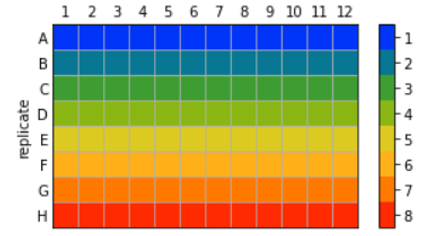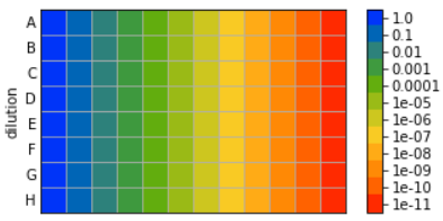MicroMPN: Software to estimate Most Probable Number (MPN) bacterial abundance from microplates.
Project description
MicroMPN: Software for automating most probable number (MPN) estimates from laboratory microplates
Authors
- Adam Rivers, United States Department of Agriculture, Agricultural Research Service
- Karla Franco Meléndez, United States Department of Agriculture, Agricultural Research Service
About MPN
Most probable number (MPN) is a way of estimating how many viable bacteria are in a sample. A series of dilutions are made with replication and the number of tubes or wells with bacterial growth is recorded. This presence/absence and dilution information is used to calculate the most probable number of bacteria in a starting sample.
With liquid handling robots and plate reader this method can be baster than conventional plate counting or spotting for some applications.
With liquid handling robots and plate reader this method can be faster than conventional plate counting or spotting on agar for some applications.
About MicroMPN
This python package has a command line program processing data from a plate reader. Users provide two types of files: A plate layout file specified in Wellmap format and a CSV plate reader file with columns for the plate, the well or row and column and the optical value used for determining growth.
Developers of Python Packages who need an MPN calculation may want to use MicroMPN's mpn estimation function. This is to my knowledge the only python implementation of MPN estimation in the Python Package Index. This function is derived from Martine Ferguson and John Ihrie's MPN R package:
Martine Ferguson and John Ihrie. (2019). MPN: Most Probable Number and Other Microbial Enumeration Techniques. R package version 0.3.0. https://CRAN.R-project.org/package=MPN .
Installing
- To install from Github:
git clone git@github.com:USDA-ARS-GBRU/micrompn.git
cd micrompn
pip install .
- To install from PyPI:
pip install micrompn
Getting Started
MicroMPN uses two types of files, a file specifying the layout of the plate and a file containing the data from the plate reader.
- A Wellmap TOML format is a simple way of specifying plate layouts. The Wellmap site has extensive documentation about how to specify the layout.
An example of the format is below. Features can be specifies by rows columns or blocks:
[col]
1.dilution = 1e00
2.dilution = 1e-01
3.dilution = 1e-02
4.dilution = 1e-03
5.dilution = 1e-04
6.dilution = 1e-05
7.dilution = 1e-06
8.dilution = 1e-07
9.dilution = 1e-08
10.dilution = 1e-09
11.dilution = 1e-10
12.dilution = 1e-11
[row]
A.replicate = 1
B.replicate = 2
C.replicate = 3
D.replicate = 4
E.replicate = 5
F.replicate = 6
G.replicate = 7
H.replicate = 8
[block.12x8.'A1']
sample = 1
Example of the above TOML layout visualized graphically with the Wellmap command wellmap.show("microplate.toml")
- Plate reader CSV files
-
Plate reader data files vary by instrument but most allow the output of data in tabular format.
-
The named columns needed in a CSV are:
- a plate column
- a well column OR plate column AND plate row columns
- an optical value column used for the determination of growth
plate_unique, plate_id, plate_well, rfu
plate_0, RFP_1_plate_1_shaking, A1, 27.081
plate_0, RFP_1_plate_1_shaking, A2, 22.001
plate_0, RFP_1_plate_1_shaking, A3, 12.949
plate_0, RFP_1_plate_1_shaking, A4, 10.328
plate_0, RFP_1_plate_1_shaking, A5, 9.264
plate_0, RFP_1_plate_1_shaking, A6, 10.017
plate_0, RFP_1_plate_1_shaking, A7, 9.373
plate_0, RFP_1_plate_1_shaking, A8, 9.049
plate_0, RFP_1_plate_1_shaking, A9, 3.78
-
The names of these columns are specified in the command-line input "micrompn".
-
After running MicroMPN the user will be provided with a CSV containing MPN estimates for each plate and sample
plate sample mpn mpn_adj upper lower
0 plate_0 0 1.005445e+08 9.220112e+07 2.295985e+08 2.295985e+08
1 plate_1 1 1.124383e+08 1.029753e+08 2.609546e+08 2.609546e+08
2 plate_2 2 3.388299e+07 2.797877e+07 6.811641e+07 6.811641e+07
3 plate_3 3 7.636579e+06 6.877494e+06 1.828966e+07 1.828966e+07
4 plate_4 4 7.515884e+05 6.752848e+05 1.195778e+06 1.195778e+06
5 plate_5 5 1.032498e+04 9.468444e+03 1.668272e+04 1.668272e+04
- The output contains the MPN, an MPN value corrected for bias due to the number of tubes used and the concentration and an upper and lower bound of the estimate. MicroMPN uses the 95% confidence bound estimation form Jarvis et al. 2010.
Jarvis B, Wilrich C, Wilrich P-T (2010). "Reconsideration of the derivation of Most Probable Numbers, their standard deviations, confidence bounds and rarity values." Journal of Applied Microbiology, 1 09, 1660-1667. https://doi.org/10.1111/j.1365-2672.2010.04792.x
Usage
MicroMPN: Software to estimate Most Probable Number (MPN) bacterial abundance from
microplates
options:
-h, --help show this help message and exit
--wellmap WELLMAP A TOML file with plate layout specified in wellmap format
--data DATA A csv file or a directory containing csv files with the plate
name, optical value, and well or row and column data
--cutoff CUTOFF The value from the plate reader above which a well is
classified as positive
--outfile OUTFILE The file path and name for the results
--plate_name PLATE_NAME
The name of the column containing the plate identifier in the
data file
--value_name VALUE_NAME
The name of the column containing the optical signal column
in the data file
--well_name WELL_NAME
The name of the column containing the well identifier in the
data file
--col_name COL_NAME The name of the column containing the plate column identifier
in the data file
--row_name ROW_NAME The name of the column containing the plate row identifier in
the data file
--zero_padded If present, the well value in the data file is treated as
zero-padded, e.g. A01
--trim_positives If present, the list of positive wells will be trimmed to the
most dilute all positive dilution and the least dilute all
negative dilution. This helps if early dilutions have improbable
wells.
--version, -v show program's version number and exit
--logfile LOGFILE, -l LOGFILE
The command line options are listed above.
Example
micrompn --wellmap micrompn/data/example1_mapfile.toml \
--data micrompn/data/example1_plate_data.csv \
--well_name plate_well \
--plate_name plate_unique \
--outfile test-output-cutoff6-trimmed.csv \
--trim_positive \
--cutoff 6
Project details
Release history Release notifications | RSS feed
Download files
Download the file for your platform. If you're not sure which to choose, learn more about installing packages.
Source Distribution
Built Distribution
File details
Details for the file micrompn-1.0.1.tar.gz.
File metadata
- Download URL: micrompn-1.0.1.tar.gz
- Upload date:
- Size: 50.4 kB
- Tags: Source
- Uploaded using Trusted Publishing? No
- Uploaded via: twine/4.0.2 CPython/3.11.3
File hashes
| Algorithm | Hash digest | |
|---|---|---|
| SHA256 |
03175b69ce93ad40b8a60384a375effa9876ac7e7a698148c8b2da3c93aa7cac
|
|
| MD5 |
a53158f0e3a0246f3082ee708f8cc5c1
|
|
| BLAKE2b-256 |
81953d24d161c26b11f05b1e72486dec5b0045663ecc07a4eeac27d3bfc2ef05
|
File details
Details for the file micrompn-1.0.1-py3-none-any.whl.
File metadata
- Download URL: micrompn-1.0.1-py3-none-any.whl
- Upload date:
- Size: 46.1 kB
- Tags: Python 3
- Uploaded using Trusted Publishing? No
- Uploaded via: twine/4.0.2 CPython/3.11.3
File hashes
| Algorithm | Hash digest | |
|---|---|---|
| SHA256 |
23df5b8260aa3b1a6525fe5fd53d1b8408bd6909b9d8179f7932a4bbe5df8c9d
|
|
| MD5 |
c15788b183a1ec32729a583b192966d5
|
|
| BLAKE2b-256 |
f66093acc2d68abdc20e58525f0bfed96cc4d6b8de2569964fadc1ddc7a243e3
|














